-

新人教版高中英语选修2Unit 4 Journey Across a Vast Land教学设计
当孩子们由父母陪同时,他们才被允许进入这个运动场。3.过去分词(短语)作状语时的几种特殊情况(1)过去分词(短语)在句中作时间、条件、原因、让步状语时,相当于对应的时间、条件、原因及让步状语从句。Seen from the top of the mountain (=When it is seen from the top of the mountain), the whole town looks more beautiful.从山顶上看,整个城市看起来更美了。Given ten more minutes (=If we are given ten more minutes), we will finish the work perfectly.如果多给十分钟,我们会完美地完成这项工作。Greatly touched by his words (=Because she was greatly touched by his words), she was full of tears.由于被他的话深深地感动,她满眼泪花。Warned of the storm (=Though they were warned of the storm), the farmers were still working on the farm.尽管被警告了风暴的到来,但农民们仍在农场干活。(2)过去分词(短语)在句中作伴随、方式等状语时,可改为句子的并列谓语或改为并列分句。The teacher came into the room, followed by two students (=and was followed by two students).后面跟着两个学生,老师走进了房间。He spent the whole afternoon, accompanied by his mom(=and was accompanied by his mom).他由母亲陪着度过了一整个下午。

新人教版高中英语选修2Unit 1 Science and Scientists-Learning about Language教学设计
Step 7: complete the discourse according to the grammar rules.Cholera used to be one of the most 1.__________ (fear) diseases in the world. In the early 19th century, _2_________ an outbreak of cholera hit Europe, millions of people died. But neither its cause, 3__________ its cure was understood. A British doctor, John Snow, wanted to solve the problem and he knew that cholera would not be controlled _4_________ its cause was found. In general, there were two contradictory theories 5 __________ explained how cholera spread. The first suggested that bad air caused the disease. The second was that cholera was caused by an _6_________(infect) from germs in food or water. John Snow thought that the second theory was correct but he needed proof. So when another outbreak of cholera hit London in 1854, he began to investigate. Later, with all the evidence he _7_________ (gather), John Snow was able to announce that the pump water carried cholera germs. Therefore, he had the handle of the pump _8_________ (remove) so that it couldn't be used. Through his intervention,the disease was stopped in its tracks. What is more, John Snow found that some companies sold water from the River Thames that __9__________________ (pollute) by raw waste. The people who drank this water were much more likely _10_________ (get) cholera than those who drank pure or boiled water. Through John Snow's efforts, the _11_________ (threaten) of cholera around the world saw a substantial increase. Keys: 1.feared 2.when 3. nor 4.unless 5.that/which 6.infection 7.had gathered 8.removed 9.was polluted 10.to get 11. threat

新人教版高中英语选修2Unit 1 Science and Scientists-Reading and thinking教学设计
Step 5: After learning the text, discuss with your peers about the following questions:1.John Snow believed Idea 2 was right. How did he finally prove it?2. Do you think John Snow would have solved this problem without the map?3. Cholera is a 19th century disease. What disease do you think is similar to cholera today?SARS and Covid-19 because they are both deadly and fatally infectious, have an unknown cause and need serious public health care to solve them urgently.keys:1. John Snow finally proved his idea because he found an outbreak that was clearly related to cholera, collected information and was able to tie cases outside the area to the polluted water.2. No. The map helped John Snow organize his ideas. He was able to identify those households that had had many deaths and check their water-drinking habits. He identified those houses that had had no deaths and surveyed their drinking habits. The evidence clearly pointed to the polluted water being the cause.3. SARS and Covid-19 because they are both deadly and fatally infectious, have an unknown cause and need serious public health care to solve them urgently.Step 6: Consolidate what you have learned by filling in the blanks:John Snow was a well-known _1___ in London in the _2__ century. He wanted to find the _3_____ of cholera in order to help people ___4_____ it. In 1854 when a cholera __5__ London, he began to gather information. He ___6__ on a map ___7___ all the dead people had lived and he found that many people who had ___8____ (drink) the dirty water from the __9____ died. So he decided that the polluted water ___10____ cholera. He suggested that the ___11__ of all water supplies should be _12______ and new methods of dealing with ____13___ water be found. Finally, “King Cholera” was __14_____.Keys: 1. doctor 2. 19th 3.cause 4.infected with 5.hit 6.marked 7.where 8.drunk 9.pump 10.carried 11.source 12.examined 13.polluted 14.defeatedHomework: Retell the text after class and preview its language points

新人教版高中英语选修2Unit 1 Science and Scientists-Using langauge教学设计
This happens because the dish soap molecules have a strong negative charge, and the milk molecules have a strong positive charge. Like magnets, these molecules are attracted to each other, and so they appear to move around on the plate, taking the food coloring with them, making it look like the colors are quickly moving to escape from the soap.Listening text:? Judy: Oh, I'm so sorry that you were ill and couldn't come with us on our field trip. How are you feeling now? Better?? Bill: Much better, thanks. But how was it?? Judy: Wonderful! I especially liked an area of the museum called Light Games.it was really cool. They had a hall of mirrors where I could see myself reflected thousands of times!? Bill: A hall of mirrors can be a lot of fun. What else did they have?? Judy: Well, they had an experiment where we looked at a blue screen for a while, and then suddenly we could see tiny bright lights moving around on it. You'll never guess what those bright lights were!? Bill: Come on, tell me!? Judy: They were our own blood cells. For some reason, our eyes play tricks on us when we look at a blue screen, and we can see our own blood cells moving around like little lights! But there was another thing I liked better. I stood in front of a white light, and it cast different shadows of me in every color of the rainbow!? Bill: Oh, I wish I had been there. Tell me more!? Judy: Well, they had another area for sound. They had a giant piano keyboard that you could use your feet to play. But then, instead of playing the sounds of a piano, it played the voices of classical singers! Then they had a giant dish, and when you spoke into it, it reflected the sound back and made it louder. You could use it to speak in a whisper to someone 17 meters away.? Bill: It all sounds so cool. I wish I could have gone with you? Judy: I know, but we can go together this weekend. I'd love to go there again!? Bill: That sounds like a great idea!

新人教版高中英语选修2Unit 2 Bridging Cultures-Discovering useful structures教学设计
The grammar of this unit is designed to review noun clauses. Sentences that use nouns in a sentence are called noun clauses. Nominal clauses can act as subject, object, predicate, appositive and other components in compound sentences. According to the above-mentioned different grammatical functions, nominal clauses are divided into subject clause, object clause, predicate clause and appositive clause. In this unit, we will review the three kinds of nominal clauses. Appositive clauses are not required to be mastered in the optional compulsory stage, so they are not involved.1. Guide the students to judge the compound sentences and determine the composition of the clauses in the sentence.2. Instruct students to try to learn grammar by generalizing grammar rules, controlling written practice, and semi-open oral output.3. Inspire the students to systematize the function and usage of noun clause1.Instruct students to try to learn grammar by generalizing grammar rules, controlling written practice, and semi-open oral output.2.Inspire the students to systematize the function and usage of noun clauseStep1: The teacher ask studetns to find out more nominal clauses from the reading passage and udnerline the nominal clauses.

新人教版高中英语选修2Unit 3 Food and Culture-Discovering useful structures教学设计
The newspaper reported more than 100 people had been killed in the thunderstorm.报纸报道说有一百多人在暴风雨中丧生。(2)before、when、by the time、until、after、once等引导的时间状语从句的谓语是一般过去时,以及by、before后面接过去的时间时,主句动作发生在从句的动作或过去的时间之前且表示被动时,要用过去完成时的被动语态。By the time my brother was 10, he had been sent to Italy.我弟弟10岁前就已经被送到意大利了。Tons of rice had been produced by the end of last month. 到上月底已生产了好几吨大米。(3) It was the first/second/last ... time that ...句中that引导的定语从句中,主语与谓语构成被动关系时,要用过去完成时的被动语态。It was the first time that I had seen the night fact to face in one and a half years. 这是我一年半以来第一次亲眼目睹夜晚的景色。(4)在虚拟语气中,条件句表示与过去事实相反,且主语与谓语构成被动关系时,要用过去完成时的被动语态。If I had been instructed by him earlier, I would have finished the task.如果我早一点得到他的指示,我早就完成这项任务了。If I had hurried, I wouldn't have missed the train.如果我快点的话,我就不会误了火车。If you had been at the party, you would have met him. 如果你去了晚会,你就会见到他的。

新人教版高中英语选修2Unit 3 Food and Culture-Reading and thinking教学设计
The discourse explores the link between food and culture from a foreign’s perspective and it records some authentic Chinese food and illustrates the cultural meaning, gerography features and historic tradition that the food reflects. It is aimed to lead students to understand and think about the connection between food and culture. While teaching, the teacher should instruct students to find out the writing order and the writer’s experieces and feelings towards Chinese food and culture.1.Guide the students to read the text, sort out the information and dig out the topic.2.Understand the cultural connotation, regional characteristics and historical tradition of Chinese cuisine3.Understand and explore the relationship between food and people's personality4.Guide the students to use the cohesive words in the text5.Lead students to accurately grasp the real meaning of the information and improve the overall understanding ability by understanding the implied meaning behind the text.1. Enable the Ss to understand the structure and the writing style of the passage well.2. Lead the Ss to understand and think further about the connection between food and geography and local character traits.Step1: Prediction before reading. Before you read, look at the title, and the picture. What do you think this article is about?keys:It is about various culture and cuisine about a place or some countries.

新人教版高中英语选修2Unit 5 First Aid-Discovering useful structures教学设计
You have no excuse for not going.你没有理由不去。He was punished for not having finished his homework.他因未完成作业而受到惩罚。2.动词ing形式复合结构由物主代词或人称代词宾格、名词所有格或普通格加动词ing,即“sb./sb.'s+doing”构成。动词ing形式的复合结构实际上是给动词ing形式加了一个逻辑主语。动词ing形式的复合结构有四种形式:①形容词性物主代词+动词ing②名词所有格+动词ing③代词宾格+动词ing④名词+动词ingHer coming to help encouraged all of us.她来帮忙鼓舞了我们所有人。The baby was made awake by the door suddenly shutting.这个婴儿被突然的关门声吵醒了。Can you imagine him/Jack cooking at home?你能想象他/杰克在家做饭的样子吗?无生命名词无论是作主语还是作宾语都不能用第②种形式。Tom's winning first prize last year impressed me a lot.汤姆去年得了一等奖使我印象深刻。Do you mind my/me/Jack's/Jack leaving now?你介意我/杰克现在离开吗?Excuse me for my not coming on time.很抱歉我没能按时来。His father's being ill made him worried.他父亲病了,他很担心。We are looking forward to the singer's/the singer to give us a concert.我们盼望着这位歌手来给我们举办一场演唱会。
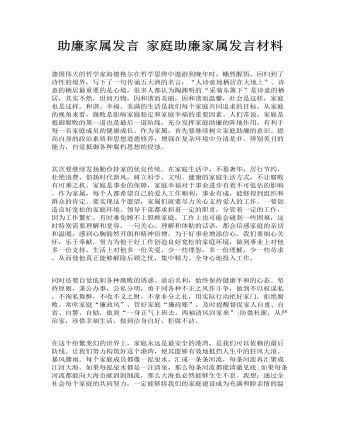
助廉家属发言 家庭助廉家属发言材料
同时还要自觉低制各种腐败的诱惑。淡泊名利,始终保持健康平和的心态。坚持原则,秉公办事,公私分明,勇于同各种不正之风作斗争,做到不以权谋私,不徇私舞弊,不收不义之财,不拿非分之礼,用实际行动把好家门,拒绝腐败。常吹家庭“廉政风”,管好家庭“廉政账”,及时提醒督促家人自重、自省、自警、自励,做到“一身正气上班去,两袖清风回家来”;防微杜渐,从严治家,珍惜幸福生活,做到洁身自好,拒腐不沾。
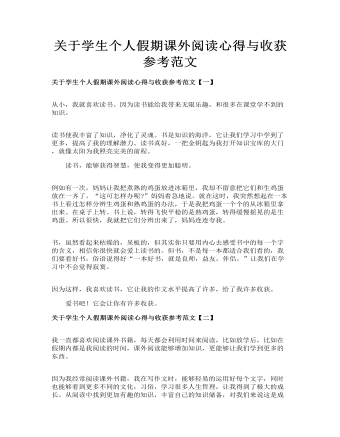
关于学生个人假期课外阅读心得与收获参考范文
我一直都喜欢阅读课外书籍,每天都会利用时间来阅读,比如放学后,比如在假期内都是我阅读的时间,课外阅读能够增加知识,更能够让我们学到更多的东西。 因为我经常阅读课外书籍,我在写作文时,能够轻易的运用好每个文字,同时也能够看到更多不同的文化,习俗,学习很多人生哲理,让我得到了极大的成长。从阅读中找到更加有趣的知识,丰富自己的知识储备,对我们来说这是成长,更是一次体验,课外阅读的好处不光是这些,更能够提升我们的阅读理解能力。

幼儿园大班社会教案:小铜人和小蜡人
活动准备: 《幼儿用书》人手一册。 调查表《长处和短处》。 活动过程: 1、倾听故事《小铜人和小蜡人》,感知理解故事内容。 教师引导幼儿打开《幼儿用书》至故事《小铜人和小蜡人》。 教师带领幼儿边看图边倾听故事。 教师:故事里有谁?小铜人有什么优点?小蜡人有什么优点? 教师:小铜人和小蜡人有缺点吗?有什么缺点呢? 2、启发幼儿探索并讲述自己的长处。 教师:小朋友,你有优点吗?你的优点是什么? 鼓励幼儿在集体面前展示自己的优点和长处(例如:会讲故事、会跳舞、会弹琴)
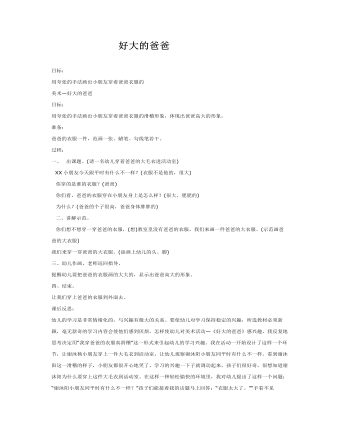
大班美术教案:好大的爸爸
目标:用夸张的手法画出小朋友穿着爸爸衣服的滑稽形象,体现出爸爸高大的形象。准备:爸爸的衣服一件,范画一张、蜡笔、勾线笔若干。过程:一、 出课题。(请一名幼儿穿着爸爸的大毛衣进活动室) XX小朋友今天跟平时有什么不一样?(衣服不是他的,很大) 你穿的是谁的衣服?(爸爸) 你们看,爸爸的衣服穿在小朋友身上是怎么样?(很大、肥肥的) 为什么?(爸爸的个子很高,爸爸身体胖胖的)
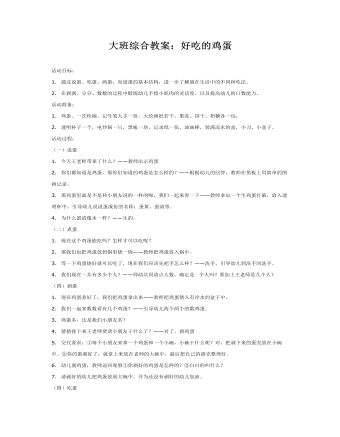
大班综合教案:好吃的鸡蛋
2. 在剥剥、分分、数数的过程中锻炼幼儿手指小肌肉的灵活度,以及提高幼儿的口数能力。 活动准备: 1. 鸡蛋、一次性碗、记号笔人手一份,大绘画纸若干,果冻、饼干、奶糖各一包, 2. 透明杯子一个,电炒锅一只,黑板一块,记录纸一张,油画棒,装满凉水的盆,小刀、小盆子。 活动过程: (一)说蛋 1. 今天王老师带来了什么?——教师出示鸡蛋 2. 你们都知道是鸡蛋,那你们知道的鸡蛋是怎么样的?——根据幼儿的回答,教师在黑板上用简单的图画记录。 3. 那鸡蛋里面是不是和小朋友说的一样的呢,我们一起来看一下——教师拿出一个生鸡蛋打破,放入透明杯中,引导幼儿说说蛋成份的名称:蛋黄、蛋清等。 4. 为什么蛋清像水一样?——生的。
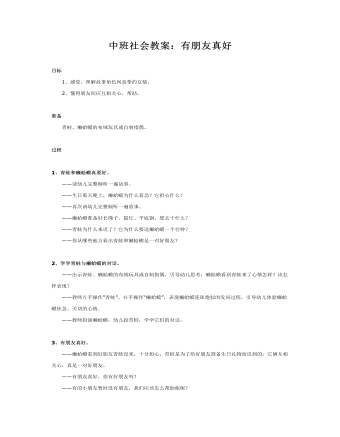
中班社会教案:有朋友真好
准备 青蛙、癞蛤蟆的布绒玩具或自制指偶。 过程 1、青蛙和癞蛤蟆真要好。——请幼儿完整倾听一遍故事。——生日那天晚上,癞蛤蟆为什么着急?它担心什么?——再次请幼儿完整倾听一遍故事。——癞蛤蟆准备好长绳子、提灯、平底锅,想去干什么?——青蛙为什么来迟了?它为什么要送癞蛤蟆一个台钟?——你从哪些地方看出青蛙和癞蛤蟆是一对好朋友?
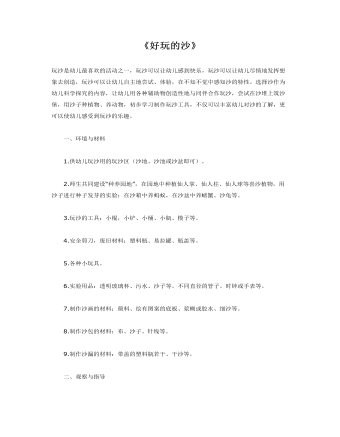
大班体育教案:好玩的沙
一、环境与材料1.供幼儿玩沙用的玩沙区(沙地、沙池或沙盆即可)。2.师生共同建设“种养园地”,在园地中种植仙人掌、仙人柱、仙人球等喜沙植物,用沙子进行种子发芽的实验;在沙箱中养蚂蚁,在沙盆中养螃蟹、沙龟等。3.玩沙的工具:小棍,小铲、小桶、小瓶、模子等。4.安全剪刀,废旧材料:塑料瓶、易拉罐、瓶盖等。5.各种小玩具。6.实验用品:透明玻璃杯、污水、沙子等。不同直径的管子。时钟或手表等。7.制作沙画的材料:颜料、绘有图案的底板、浆糊或胶水、细沙等。8.制作沙包的材料:布、沙子、针线等。9.制作沙漏的材料:带盖的塑料瓶若干、干沙等。
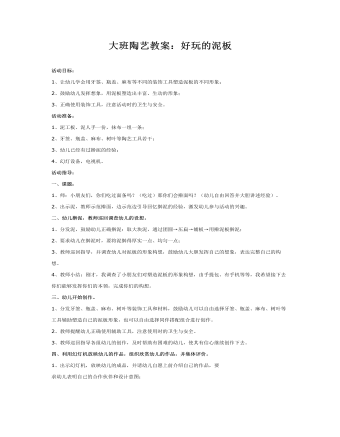
大班陶艺教案:好玩的泥板
2、鼓励幼儿发挥想象,用泥板塑造出丰富、生动的形象;3、正确使用装饰工具,注意活动时的卫生与安全。活动准备:1、泥工板、泥人手一份,抹布一组一条;2、牙签、瓶盖、麻布、树叶等陶艺工具若干;3、幼儿已经有过擀泥的经验;4、幻灯设备,电视机。活动指导:一、课题:1、师:小朋友们,你们吃过面条吗?(吃过)那你们会擀面吗?(幼儿自由回答并大胆讲述经验)。2、出示泥,教师示范擀面,边示范边引导回忆擀泥的经验,激发幼儿参与活动的兴趣。

中班综合教案好玩的皱纸
活动目标:1、在撕撕玩玩的过程中,感受皱纸的特性。2、在游戏中,体会快乐的情绪。活动准备:1、大张的皱纸1张、彩色的皱纸若干、托盘和水瓶子人手1份2、欢快的音乐CD1张3、干毛巾若干 活动过程:一、以音乐游戏《许多小鱼》的方式引出课题。幼儿扮小鱼,跟着教师边玩音乐游戏《许多小鱼》边进入活动室。师:小鱼儿们,前面有个大鱼网,跟着妈妈要小心不要被网住了哦! 二、认识皱纸,大家一起来撕一撕、揉一揉。1、师 ;刚才我们游戏中的鱼网是用什么做的?(皱纸)2、教师舞动用皱纸做的彩带,幼儿想象。师:孩子们看,我这里还有许多五颜六色的皱纸。瞧,像什么?(幼儿自由想象并大胆回答)3、幼儿尝试着撕皱纸。A、师: 谁知道这细细长长的皱纸是怎么来的?(用小手撕出来的)B、请个别幼儿上来试试。C、教师提示:按照皱纸纹路撕出长条。4、幼儿操作

国旗下讲话:《做更好的自己》
12月10日我们将迎来建校10周年暨实验学校、大泊中小学三校整合庆典活动。庆典活动之前我们校园里将树立一座孔子像。今天我讲话就以孔子的一句话来要求大家“做更好的自己”。子曰:“德之不修,学之不讲,闻义不能徙,不善不能改,是吾忧也。”就是说:不培养品德,不钻研学问,知道怎样做符合道义的事却不能改变自己,有缺点不能及时改正,这些都是我忧虑的。圣贤孔子所最忧虑的不是国家表面的旦夕祸福,而是人的四大弱点。“德”被放在了最首,可见品德的重要性。细细想来,那些最受历史垂青的人,无不是光明磊落的正人君子。所以,即便你功成名就,可没有美好高尚的品德,再多的金钱与荣耀也无法带给你纯粹的快乐。第二是“学”。这里的学,不是单纯意义上的学习,而是指钻研。芸芸众生的竞争当中,真正脱颖而出的,屈指可数,有道是“学者如牛毛,成者如麟角”。而那“学者”与“成者”的区别,决不是先天智力因素所引起的。伟大的科学家如:爱因斯坦、牛顿等等,他们的成就,绝非是超凡的智商或是惊人的天赋带来的,这光鲜与荣耀,是他们毕生钻研的成果
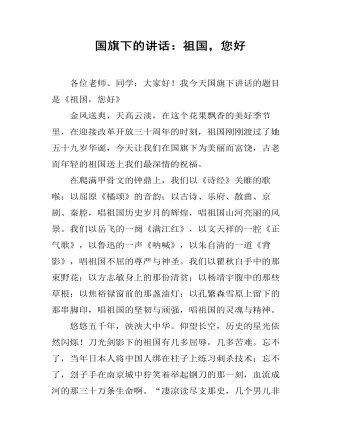
国旗下的讲话:祖国,您好
各位老师、同学:大家好!我今天国旗下讲话的题目是《祖国,您好》金风送爽,天高云淡,在这个花果飘香的美好季节里,在迎接改革开放三十周年的时刻,祖国刚刚渡过了她五十九岁华诞,今天让我们在国旗下为美丽而富饶,古老而年轻的祖国送上我们最深情的祝福。在爬满甲骨文的钟鼎上,我们以《诗经》关睢的歌喉;以屈原《橘颂》的音韵;以古诗、乐府、散曲、京剧、秦腔,唱祖国历史岁月的辉煌,唱祖国山河亮丽的风景。我们以岳飞的一阕《满江红》,以文天祥的一腔《正气歌》,以鲁迅的一声《呐喊》,以朱自清的一道《背影》,唱祖国不屈的尊严与神圣。我们以瞿秋白手中的那束野花;以方志敏身上的那份清贫;以杨靖宇腹中的那些草根;以焦裕禄窗前的那盏油灯;以孔繁森雪原上留下的那串脚印,唱祖国的坚韧与顽强,唱祖国的灵魂与精神。悠悠五千年,泱泱大中华。仰望长空,历史的星光依然闪烁!刀光剑影下的祖国有几多屈辱,几多苦难。忘不了,当年日本人将中国人绑在柱子上练习刺杀技术;忘不了,刽子手在南京城中狞笑着举起钢刀的那一刻,血流成河的那三十万条生命啊。“凄凉读尽支那史,几个男儿非马牛?”

国旗下的讲话:做最好的自己
亲爱的同学们,当你们走进附中校门的那一刻,你们都对高中生活充满了憧憬和期待,人人都有自己的梦想,人人都希望心想事成。如今高中生活不觉已度过了六分之一,你们正在经历着自己的努力,也收获着自己的努力,也继续奋斗着自己的努力。老师真诚的希望你们在今后的学习生活中一如既往的保持努力,做最好的自己。要做最好的自己,就要严格要求自己,自觉遵守学校纪律,上学不迟到,自习不说话,上课专心听;作业独立做,课本仔细看,学案认真写,有问题及时请教老师;课间操迅速到位,跑步速度快,精神面貌好。要做最好的自己,就要珍惜你的分分秒秒,不虚度青春年华。一走进校门,就不要再听mp3,就不要再玩手机,就不要看影响你学业进步的杂书,更不要不经老师允许上网看电影。你们需要活动也应该活动,但不能让篮球、足球占领你的大脑。你们的时间太过宝贵,老师知道你真的浪费不起、挥霍不起。

